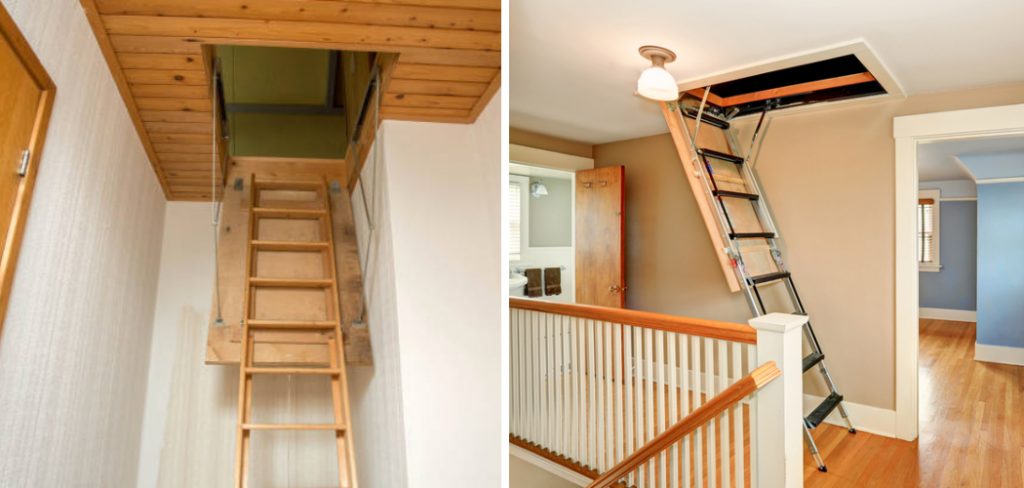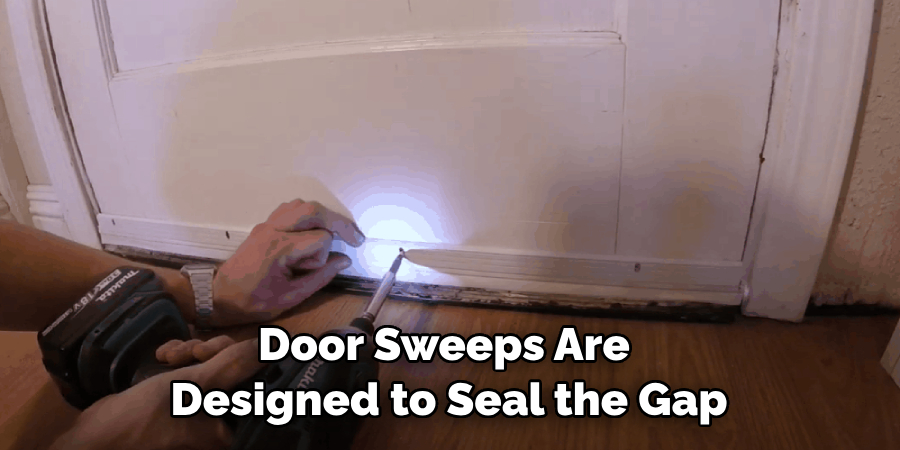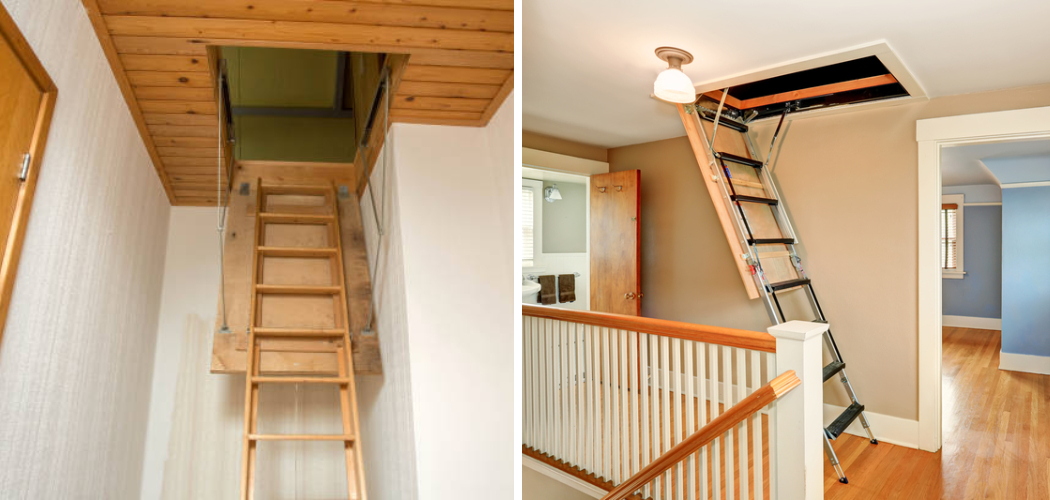Do you feel a draft coming through your attic door every time you walk by? Not only can drafts be annoying, they’re also expensive as drafts can contribute to higher energy bills.

If this is the case in your home, don’t worry – stopping a draft around an attic door doesn’t have to be complicated or costly! Here’s a helpful guide that’ll help you manage the pesky draft from your attic door so you can make sure it stays snug and secure all season long.
Fortunately, with just a few simple tools and supplies, you can quickly diagnose any draft situation and take steps to reduce wear-and-tear on your home’s heating system. In this guide, we’ll explore the signs that indicate an attic door leak as well as explain how to stop draft from attic door—saving money while keeping warm! So let’s get started…
What Causes Draft in Attic Door?
1. Improperly installed attic door
If the seal around your attic door is not tight, cold air can be drawn in from outside. This can lead to drafty conditions and increased energy costs. To prevent this, check that the door fits snugly in its frame and no air is leaking through any cracks or gaps.
2. Poor insulation
Insulation helps to reduce the transfer of heat and as a result can help prevent drafts from entering your attic. Make sure that any insulation around the door is in good condition and properly sealed, with no gaps or holes where air can escape through.
3. Inadequate weatherstripping
Weatherstripping is designed to seal gaps between two surfaces and can help reduce the amount of air that enters your attic. Inspect any weatherstripping around the door frame to make sure it is in good condition and not wearing away.

Why is It Important to Stop Draft From Attic Door?
1. To Reduce Energy Costs
Drafts coming from the attic door can cause your heating and cooling system to work harder and use more energy, which results in higher monthly energy bills. This will have a negative impact on your pocketbook, so it is important to take action to reduce draft from the attic door.
2. To Improve Comfort Level
Drafts can make the temperature in your home inconsistent and uncomfortable. This can be especially true when you are trying to sleep at night during colder months or relax during hotter summer days. You can reduce draft and make your home more comfortable by sealing the attic door.
3. To Improve Air Quality
Drafts can bring in allergens, dust, and other contaminants that can lead to indoor air pollution. By stopping draft from the attic door, you can create a cleaner environment for your family. Also, you can reduce the strain on your HVAC system and help it to last longer.
4. To Protect Your Home
Over time, drafts can cause damage to your home’s structure if they are not addressed. This can include cracking or warping of walls and ceilings, as well as condensation that leads to mold growth. Sealing the draft from the attic door will prevent these issues and help protect your home in the long run.
Taking action to stop drafts from coming in through the attic door can have lasting benefits. Sealing the door properly will help reduce energy costs, improve comfort level, and even improve air quality in your home. Investing a little time and effort now in sealing the attic door can pay off with greater savings and better living conditions for you and your family.
12 Tips On How to Stop Draft From Attic Door
1. Inspect the Attic Door and Frame
Start by examining the attic door and frame for any cracks or gaps where air can escape. Pay close attention to the weatherstripping around the door, as it may need to be replaced if it is worn down or damaged. Also, ensure that the door is properly sealed to the frame.
2. Add Insulation

Insulating your attic door can help reduce drafts and air leakage significantly. You can install a foam insulation board around the door or use weatherstripping to seal off gaps and cracks. Both methods are simple and cost-effective ways to help keep warm air in and cold air out.
3. Use a Draft Stopper
A draft stopper is an effective way to reduce drafts from attic doors. They are usually made of heavy fabric filled with batting or foam and sit on the floor directly under the door. This will help prevent air from infiltrating your home through any cracks or gaps in the door.
4. Hang Heavy Curtains
Hanging heavy curtains over your attic door is another great way to reduce drafts and energy loss. Choose thick, lined curtains that are able to block out some of the cold air from entering your home. Additionally, you can install a second set of curtains inside your attic for added insulation.
5. Install Door Sweeps
Door sweeps are designed to seal the gap between your attic door and frame, allowing them to fit tightly together. This will help reduce air leakage and drafts from entering through the bottom of the door. They come in various sizes so make sure you get one that fits your particular door size.

6. Replace the Door
In extreme cases, you may need to replace your attic door with one that is better insulated and sealed. Consider getting a solid-core door for added insulation, or opt for an energy-saving option like a low-emissive door.
7. Install Exhaust Fans
If your attic gets hot during the summer months, installing an exhaust fan is a great way to reduce heat buildup and keep the space cooler. This will also help reduce drafts that can enter through the attic door.
8. Check for Leaks
Your attic should be sealed from any sources of outside air. Make sure there are no openings around windows or vents where air can escape, as this could be adding to your draft problem.
9. Invest in a Dehumidifier
If you have moisture build up in your attic, it can cause drafts and unpleasant odors. Investing in a drum. Additionally, inspect the roof for any holes or leaks and make sure they are properly sealed. Also, pay attention to the insulation in your attic. Proper insulation will help keep warm air in and cold air out.
10. Check Your Attic Stairwell
Your attic stairwell may have a draft door that needs to be sealed. Install weatherstripping or use caulk to seal up any gaps or cracks around the doorway.

11. Use Door Seals
Door seals are a great way to reduce air leakage and drafts from entering your attic through the door. They can be easily installed by attaching them onto the inside of the frame with nails or screws.
12. Install a Heat Recovery Ventilator
A heat recovery ventilator (HRV) is an energy-efficient way to help reduce drafts and air leakage in your attic. This device uses the warm air from inside your home to heat up cold air coming from outside, helping to regulate temperature levels within the space.
By making a few simple changes and following these tips, you can keep drafts out of your attic door and make your home more comfortable and energy-efficient. Investing a little time in sealing up the door can help you save money on energy bills and protect both your wallet and your home.
Frequently Asked Questions
What Precautions Should I Take to Prevent Drafts From an Attic Door?
Drafts in your attic can be caused by a number of factors, including poor insulation, air infiltration, and worn weatherstripping. Taking proper precautionary measures can help you prevent drafts from coming through an attic door. Check the insulation in your attic before attempting any other fixes and ensure the R-value of your insulation is suitable for your climate.
Once you have sufficient insulation, inspect the weatherstripping around the door frame to make sure it’s still in good condition. If not, replace it with new weatherstripping that fits snugly into the doorjamb. Additionally, apply caulk to seal any gaps or cracks around the door frame.
If you have an attic fan, make sure it is properly sealed and insulated as well. Finally, consider investing in a draft stopper for your attic door; these devices create a barrier that blocks air from passing through the gaps in the door frame. With these simple steps, you can successfully prevent drafts from entering your attic through the door.

What Is the Best Way to Insulate an Attic Door?
Insulating an attic door is a great way to reduce air infiltration and keep out drafts. The best way to insulate an attic door is by using a combination of foam board insulation, fiberglass batting, and weatherstripping. Foam board insulation should be installed on the interior side of the door, covering it from top to bottom.
Once the foam board is in place, use fiberglass batting to cover any gaps or cracks around the door frame. Finally, install weatherstripping along the edges of the door frame to create a tight seal when you close it. This basic insulation setup can help you significantly reduce drafts coming from an attic door.
What Are the Benefits of Investing in a Draft Stopper for My Attic Door?
Draft stoppers are designed specifically to stop drafts from entering your attic through the door. These devices create a barrier between the door and floor that prevents air from passing through the gaps in the door frame.
Draft stoppers are relatively inexpensive and can be easily installed in just a few minutes. This simple solution is an effective way to keep your attic temperature regulated and reduce energy costs associated with heating or cooling your home.
How Much Does It Cost to Install Weatherstripping Around an Attic Door?
The cost of installing weatherstripping around an attic door depends on the type of material used and the size of the door frame. Generally speaking, basic rubber or foam weatherstripping can be purchased for as little as $10-15 for a roll that’s enough to cover the entire frame.
Professional installation may cost a bit more, depending on the complexity of the job. However, it’s well worth the investment as weatherstripping can help you save significantly on energy costs in the long run.
What Other Tips Can Help Me Keep My Attic Warm?
In addition to installing insulation and weatherstripping around your attic door, there are a few other tips you can use to keep your attic warm. Seal up any air leaks in the walls or ceiling with caulk or foam sealant, and make sure all windows and doors are properly sealed as well.
You may also want to install a ventilation system in your attic to help circulate warm air. Finally, consider investing in a programmable thermostat that can help you keep your attic at the ideal temperature all year long.

These tips should be sufficient to address any issues with drafts coming through an attic door and keep your home comfortable all winter long. With the right precautions, you can successfully prevent cold drafts from entering your attic and save on energy costs in the process.
Conclusion
Drafts coming through attic doors can be an inconvenient problem. Through creating a tight seal, changing the structure of the attic door, or adjusting the weatherstripping materials, you can make your home more efficient and comfortable.
It’s an easy solution that requires minimal effort on your part. Although there are some cases where you may have to call in a professional, a well-constructed do-it-yourself plan usually works just fine for this type of project.
Now you know how to stop draft from attic door! Clients who need more than simple measures will benefit from consulting with a qualified contractor who can provide the necessary tools and materials needed to stop draught and other insulation problems in attics.
Remember, stopping drafts is not only essential for keeping the house cozy but also helps improve energy efficiency within your home, reducing bills and helping preserve our environment. That’s one drafty situation worth solving!

